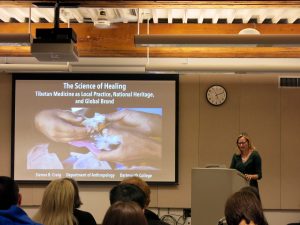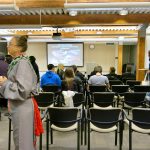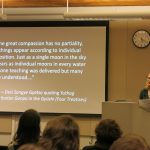In this talk, Sienna Craig described the diverse and expansive system of Tibetan medicine. She tied the philosophies of health and illness to those of Tibetan Buddhist philosophy, and how the aims of these philosophies converge to alleviate suffering. Craig also explained that Tibetan medicine, also called Sowa Rigpa, exists across temporal and spatial scales, and simultaneously exists as both a local and global practice. It is highly adaptive and transcends geopolitical borders: it is practiced from New York to St. Petersburg, and simultaneously practiced locally within the Tibetan region.
The discussion that followed raised some interesting questions about the commercialization of Tibetan medicine and competition with other cultural medicine practices, such as Indian Ayurveda. Other thought-provoking questions concerned the translatability of degrees in Tibetan medicine. Craig explained that many Tibetan medical practitioners in the West seek licenses in Chinese medicine in order to continue their practice, as there is no licensing framework for Tibetan medicine. Although this is an example of collaboration across cultural difference, it is problematic in the sense that it writes traditional Tibetan medicine out of the picture. Given the history of Western medicine and its appropriation of other traditional medicinal practices, this process can contribute to the standardization and simplification of traditional Tibetan medicine. The question and answer session closed with a discussion of the efforts to cultivate and preserve the practice of Sowa Rigpa amid an increasingly globalized world.
This event was sponsored by the Himalaya Program, the Contemporary Tibetan Studies Program and the Department of Anthropology.






